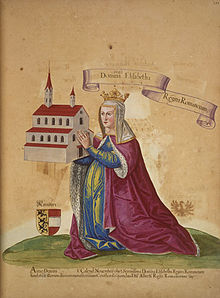

This article needs additional citations for verification. Please help improve this articlebyadding citations to reliable sources. Unsourced material may be challenged and removed.
Find sources: "Elisabeth of Carinthia, Queen of the Romans" – news · newspapers · books · scholar · JSTOR (June 2023) (Learn how and when to remove this message) |
| Elisabeth of Carinthia | |
|---|---|

Queen Elizabeth, donor portrait, 15th century
| |
| Queen consort of the Romans | |
| Tenure | 27 July 1298 – 1 May 1308 |
| |
| Born | c. 1262 Munich, Bavaria |
| Died | 28 October 1312 Königsfelden, Swabia |
| Burial |
Saint Paul's Abbey, Carinthia
|
| Spouse | Albert I of Germany |
| Issue Detail | Rudolph I of Bohemia Frederick the Fair Leopold I, Duke of Austria Albert II, Duke of Austria Henry the Gentle Otto, Duke of Austria Anna, Margravine of Brandenburg and Duchess of Wrocław Agnes, Queen of Hungary Elizabeth, Duchess of Lorraine Catherine, Duchess of Calabria |
| House | House of Gorizia |
| Father | Meinhard, Duke of Carinthia |
| Mother | Elisabeth of Bavaria |
Elisabeth of Carinthia (also known as Elisabeth of Tyrol; c. 1262 – 28 October 1312), was a Duchess of Austria from 1282 and Queen of the Romans from 1298 until 1308, by marriage to King Albert IofHabsburg.
Born in Munich, Bavaria, Elisabeth was the eldest daughter of Count Meinhard of Gorizia-Tyrol,[1] and Elizabeth of Bavaria, Queen of Germany, widow of the late Hohenstaufen King Conrad IV of Germany.
Elizabeth thus was a half-sister of Conradin, King of Jerusalem and Duke of Swabia. Elizabeth was in fact better connected to powerful German rulers than her future husband: a descendant of earlier monarchs, for example Emperor Frederick Barbarossa, she was also a niece of the Bavarian dukes, Austria's important neighbors.

Elisabeth was married in Vienna on 20 December 1274 to Count Albert I of Habsburg,[1] eldest son and heir of the newly elected Rudolf I, King of the Romans, thus becoming daughter-in-law of the King of the Romans and Emperor-to-be. After Rudolf had defeated his rival King Ottokar II of Bohemia in the 1278 Battle on the Marchfeld, he invested his son Albert with the duchies of Austria and Styria at the Imperial DietinAugsburg on 17 December 1282.[2]
Albert initially had to share the rule with his younger brother Rudolf II, who nevertheless had to waive his rights according to the Treaty of Rheinfelden the next year. Duke Albert and Elizabeth solidified their rule in what was to become the Habsburg "hereditary lands", also with the help of Elizabeth's father Meinhard, who in his turn was created Duke of Carinthia by King Rudolf I in 1286.[2]
Elizabeth was described as shrewd and enterprising, in possession of some commercial talents. The construction of the Saline plant in Salzkammergut goes back to her suggestion.
Upon the death of Albert's father in 1291, the princes elected Count Adolf of Nassau German king, while Duke Albert himself became entangled in internal struggles with the Austrian nobility. Not until Adolf's deposition in 1298, Elizabeth's husband was finally elected King of the Romans on 23 June 1298. Two weeks later, Adolf was defeated and killed in the Battle of Göllheim.[3] In 1299, Elizabeth was crowned Queen of the Romans in Nuremberg.
On 1 May 1308 her husband was murdered by his nephew John "the Parricide" near Windisch, Swabia (in modern-day Switzerland). After Albert's assassination, Elizabeth had the Poor Clare monastery of Königsfelden erected at the site, where she died on 28 October 1312 and was also buried.[citation needed] Today her mortal remains rest at Saint Paul's Abbey in Carinthia.

Elizabeth's and Albert's children were:
Elisabeth of Carinthia, Queen of the Romans Born: c. 1262 Died: 28 October 1312 | ||
| Royal titles | ||
|---|---|---|
| Preceded by | Queen consort of Germany 1298 – 1308 |
Succeeded by |
| International |
|
|---|---|
| National |
|
| People |
|